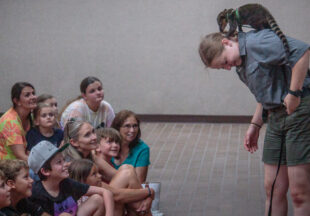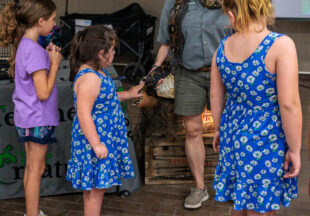Proposed wind farm in southeastern Stephens County leads to differing opinions among local landowners

By Tony Pilkington and Carla McKeown/Breckenridge Texan
There’s a battle brewing in southeastern Stephens County, pitting landowner against landowner, neighbor against neighbor, and, in some cases, kinfolk against kinfolk. Throughout the history of this land we call Texas, similar fights have been waged as humans have sought to control the natural resources here, from grasslands and hunting grounds to water and oil. But, this time, they’re seeking the rights to the wind and the land usage that is necessary to harvest its energy.
As those for and against the installation of a wind farm in Stephens County argue both sides of the situation, the deciding factor will come down to the votes of the six men and one woman who make up the Breckenridge Independent School District’s Board of Trustees.
NextEra Energy, the parent company of La Casa Wind, LLC, is considering building a wind farm in an area comprising more than 33,000 acres in the southeast portion of Stephens County. The project began several years ago under the umbrella of EC&R (Econ Climate and Renewables), which became RWE Renewables and later was acquired by NextEra.
On May 4, 2022, a representative from La Casa Wind, LLC, addressed the school board, seeking approval of an Application for Value Limitation Agreement, which would reduce the amount of taxes the wind farm company would owe. The school board’s decision must be made by Dec. 31, 2022, because that’s when the Chapter 313 of the Texas Tax Code that allows for the program expires.
In October, another La Casa Wind representative held a special workshop with the Stephens County Commissioners. La Casa Wind has indicated that they will be asking for tax abatements from the county, as well. On Monday, Nov. 14, the Stephens County Commissioners Court held a workshop for those who are opposed to the wind farm to meet with the commissioners.
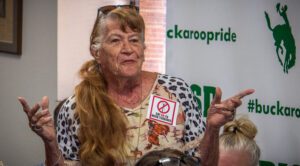
Nancy Coody Morales spoke at the Aug. 8 BISD board meeting. She said she thinks the windmills are ugly and she doesn’t want to see windmills messing up her property. (Photo by Tony Pilkington/Breckenridge Texan)
In the months since May, opponents and proponents have attended school board meetings and the County’s workshop, some to voice their opinions, some to just see what was going on. And on Wednesday, Nov. 9, about 65 people attended a BISD public hearing in Bailey Auditorium, where everyone who wanted to speak on the topic had an opportunity. Thirteen people signed up to address the school board, but one man left before it was his turn to speak. The 12 who did talk all were against the wind farm; no one spoke in favor of the project, although some supporters were in the audience. Click here to see the Breckenridge Texan’s Photo Gallery from the hearing.
Following the public hearing portion of the meeting, the school board met in a closed-door session with attorney Sara Leon about the proposed wind farm. However, no action was taken by the board on Wednesday.
Over the past six months, the Breckenridge Texan staff – Publisher Tony Pilkington and Editor Carla McKeown – have taken a deep dive into the world of wind energy. We have studied wind industry documents, government research, newspaper stories and more. We have talked to people – many people – including those who are in favor of the wind farm and those who are opposed to it, as well as some who don’t have any specific interest in wind turbines but who have insight into some of the related topics.
As a professional news organization, the Breckenridge Texan is not taking a stance for or against the installation of a wind farm in Stephens County. As journalists, we put aside any preconceived notions we may have had about wind energy and have started this local story with a blank slate. As Stephens County residents, we are able to stay neutral because we do not live in the area of the county where the proposed wind farm will be located if the project goes forward. We have found likeable people on both sides of the issue, and we can understand the reasons that each side has for their opinions. But, we will leave the opinions and decisions to those who are more directly involved.
Below is an in-depth look at some of the issues surrounding the proposed La Casa Wind LLC wind farm. It is long, but we have broken it up into sections to make it more readable. Additionally, we will cover some other related topics in upcoming articles.
HISTORY AND CURRENT PROPOSAL
As far back as 2017, wind farm companies were looking into installing turbines in Stephens County.
At that time, a group of citizens who lived in the area got together to discuss the topic.
“About five or six years ago, this part of the county met at the Wayland Fire Department,” said Mike Fields, a Stephens County resident. “And there was about over 100 people … They elected six guys at that meeting to see about wind turbines, and I was one of the six elected. And I didn’t have a clue. I didn’t know anything about wind turbines. As a matter of fact, I didn’t even know if I wanted a wind turbine. But since I was elected, I thought I better get around and find out about these things. Well, I went to Wichita Falls, Windthorst, Olney, Newcastle, Abilene, Sweetwater. Everywhere I went, I couldn’t find anybody that had an objection about them. And then I got to looking at how much area they improved that had them. And I thought, ‘Oh, why wouldn’t Breckenridge want these things?’”
According to documents on file at the Stephens County Clerk’s Office, in 2017, EC&R (Econ Climate and Renewables) contracted with about 26 property owners in Stephens County to lease property for wind energy purposes. Based on the Memorandum of Lease documents on file, several of the leases are with family trusts or family partnerships. Additionally, in some cases, the lessees have more than one lease with the company.
In 2019, those contracts were transferred to RWE Renewable Development LLC, which added seven contracts to the list. Then, in June 2021, La Casa Wind LLC took over the contracts and signed on 18 additional property owners for the project.

Melissa Bruni, a representative of NextEra, attended the May 4 BISD meeting to talk about the wind farm project and propose the Chapter 313 application to the board. (Photo by Tony Pilkington/Breckenridge Texan)
When she spoke at the May 4 BISD meeting, Melissa Bruni, a representative of NextEra, said that the company had “a little over 60 landowners currently under lease. That’s important because this is all private land. So these landowners have decided that this is what they would like to do with their lands. And they have entered into these agreements. So, all private land ownership, really excited about the project. This is our first project in this county.”
Bruni was at the meeting to present the application for a Chapter 313 Value Limitation Agreement between the Breckenridge Independent School District and La Casa Wind, LLC, which the school board accepted. By accepting the application, the school board didn’t approve the actual agreement with La Casa Wind but just agreed to accept the application and consider it.
According to the Texas Comptroller of Public Accounts website, an application for a Chapter 313 Value Limitation Agreement between the Breckenridge Independent School District and La Casa Wind, LLC, was filed electronically on May 16, 2022. Click here to see the document.
The application specifies that La Casa Wind is seeking an appraised value limitation of $20 million for the years 2028 through 2037. That means that the company is asking for the school district to limit the value of the property that the company has to pay taxes on to $20 million, regardless of how much the property is actually valued at. At the current tax rate of .94290 per $100 valuation, that would be a maximum of $188,580 per year once the property value reaches at least $20 million.
Based on other proposed and completed agreements, in return, La Casa will likely offer BISD an up-front payment and a specific amount of money per student each year for the 10 years covered under the agreement. Additionally, the school district will not actually lose out on any potential tax revenues because the State of Texas will pay BISD the difference between the taxes on the appraised value of the property and the limited value.
The Chapter 313 application describes the proposed wind farm as a 90 MW/AC wind energy generation project that will be composed of approximately 31 primary 2.82MW GE model turbines. Construction is estimated to commence in June 2026 with commercial operations beginning by the end of 2028, based on the form.
However, because the project is still in the early stages, the information is subject to change, according to Julia Schleicher, a communication specialist in marketing and communications with NextEra Energy Resources. In an email last month, she said the project is expected to have a capacity of approximately 50-150 megawatts of clean, renewable energy produced by potentially about 50 wind turbines. The project could begin construction after Spring 2023.
At the Nov. 9 public hearing, attorney Sara Leon explained that the difference in the projected start dates is likely because the Texas State Comptroller’s Office recommended, in light of the 313’s conclusion at the end of this year, that applicants put the latest start date possible on their applications. Once approved, the applications can be amended to reflect earlier start dates, if necessary, she said.
Although the application requests that the taxable value of the wind farm be limited to $20 million for 10 years, Bruni said that La Casa intends to operate the project for 35 years.
“One of the things that makes us different than a lot of other developers is we own and operate our assets. So not only have we been working with the landowners from the ground, but we anticipate on operating the wind farm for 35 years,” she said. “So that is something that makes us a little bit different, again, we own and operate our assets. So we will have NextEra employees repairing the wind turbines, and that’s also important because they’re our assets. We’re going to want to take care of and make sure they’re in good working order and that the land is maintained.”
JOB REQUIREMENTS
According to the Texas Tax Code, Chapter 313, the Texas Economic Development Act, was created to achieve several purposes, including encourage large-scale capital investments in the state and create new, high-paying jobs. For rural school districts, the number of jobs that a qualifying project must create is 10.
However, Chapter 313 also stipulates that a school district may waive the job requirement if it finds that the jobs creation requirement exceeds the industry standard for the number of employees reasonably necessary for the operation of the facility described in the application.
La Casa Wind/NextEra has requested such a waiver from BISD. Once the wind farm is constructed and operational, it will need one employee with a salary of almost $37,000 per year, according to the 313 application.
At the request of some of his constituents, Texas State Representative Glenn Rogers, who represents Stephens County, wrote a letter to BISD, voicing his opposition to the proposed agreement, based on the requested job requirement waiver.
“While I recognize the desire to bring industry into Stephens County, it is my belief that the waiver granted to NextEra Energy Resources violates the spirit of Chapter 313 abatements and promotes the unfair, selective subsidization of energy production counterintuitive to our state’s interests,” Rogers wrote. “The intent of the 2001 Texas Economic Development Act is to provide a temporary property tax exemption to businesses and industries in exchange for economic development and JOBS in the local community. Chapter 313 requires that applications be able to create at least ten qualifying jobs in rural school districts: however, the proposed La Casa Wind waiver will reduce this number from ten to one.
“While the benefit of a new industry has merit in rural communities, it is the state that will make up the difference in lost revenue to the ISD. This is a necessary trade-off to create jobs; however, when the required number of jobs is not expected to be created, the state is, in effect, subsidizing a corporation for minimal economic return.
“As a rancher and landowner, I respect the right for anyone to decide for themselves whether to place wind turbines on their property,” he continued. “In principle, I oppose any state subsidization of wind or solar, as those dilute the energy market with unreliable power generation and provide an unfair advantage to our state’s dominant energy production capabilities. However, my issue is simply that, from my understanding, the proposed La Casa Development will be a burden on the greater Texas taxpayers with marginal benefits to the community at large.”
Click here to see Rogers’ letter.
The project is expected to generate approximately 250 temporary construction jobs, according to NextEra’s application, but those jobs do not count toward the required permanent jobs stipulated in Chapter 313.
In a letter to BISD Superintendent Bryan Allen in the 313 application, Mike Fry, director of energy services for KE Andrews, a tax firm located in Rockwell, explained that the current industry standard for wind energy sites is one worker per 35-40 turbines.
“La Casa Wind, LLC has committed to create 1 full time permanent position for the operation and maintenance of the facility. The qualifying position will be compensated at the rate of 110% of the regional manufacturing wage as well as offer company benefits. Such positions shall be employed by La Casa Wind, LLC or by the contractor it employs to operate and maintain the facility,” Fry wrote in requesting that the school district waive the job creation requirement for 10 permanent jobs. “This waiver would be based on the school district’s board findings that the jobs creation requirement exceeds the industry standard for the number of employees reasonably necessary for the operation of this facility.”
QUALITY OF LIFE/VISUAL NUISANCE
Although the request for a waiver to the job creation requirement is a concern for some opposed to the approval of the Chapter 313 request, other area citizens are also worried about how the proposed wind farm will affect their home life, if it’s approved.
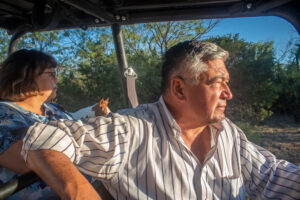
Earl and Jenny Brunner look across their property while taking visitors on a tour of the land recently. (Photo by Tony Pilkington/Breckenridge Texan)
When retired U.S. Army Col. Earl Brunner shows visitors around his place in the southeastern corner of Stephens County, he seems to get more excited with each curve he drives around. But, his favorite view on the entire 114 acres seems to be from the second floor of the house, looking toward the west with a view of the sunset every evening.
“Look how beautiful that is! Didn’t I tell you it’s great?” he said recently.
But, even though that sunset seems to be his favorite view, he’s that enthusiastic about almost every spot on the property, pointing out the different types of trees, the sturdy fencing, the pond. Brunner and his wife, Jenny, bought the place two years ago with plans to retire here and enjoy the rugged landscape with sons Evan and Cameron.
At 63, he was looking for a quiet place to raise a few cattle and enjoy the wildlife. He has a dog, several head of cattle and a rescue horse named Dora, who is blind in one eye. It’s typical of the Stephens County countryside with mesquite, cedar and oak trees, a few cactus and little tufts of wildflowers blooming here and there.
“My house is up on a ridge and overlooks a huge valley – spectacular view – you can see the different shades of green throughout the environment,” he told the BISD Board of Trustees at their July 11 meeting. “Please do not let someone take that away from me. I say it again…please do not let someone take that away from me.”
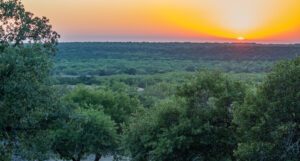
The Brunners currently have an unobstructed view of the sunset from the balcony on the second floor of their home in southeast Stephens County. They are against the wind farm because they don’t want to lose this view. (Photo by Tony Pilkington/Breckenridge Texan)
Brunner has a wildlife exemption on the land and feeds the deer and ducks, plants sunflowers for the dove, and makes sure there’s water available for all the wildlife. There’s also turkey and wild hogs on the place. His son, Evan Brunner, handles the hunting business side of the ranch to help keep everything going.
“It’s really hard to put into words, what’s going on here,” Evan said during the public comment portion of the July 11 BISD Board of Trustees meeting. “I’ve watched this man work his entire life for what he has now – 28 years in the military – I mean, that’s longer than I’ve been alive – all the sacrifice and everything. And, it’s not just him; there’s a handful of people here who have worked their entire lives for what they have now, and it’s going to be taken away from them in a heartbeat if this goes through. Nobody wants to look out the window and see a sea of red lights at night. Nobody wants a windmill … across the fence line 2,000 feet. It’s just not fair.”
Earl Brunner, who flew helicopters in the military, also is concerned about how the wind farm would affect air ambulances and fire-fighting efforts in the area. See the section below on AIR AMBULANCES/FIREFIGHTING for more details on that topic.

Jenny and Earl Brunner bought their ranch in Stephens County a couple of years ago with plans to retire here. They are opposed to the wind farm and are concerned about the effect it will have on the ability of air ambulance services to land in the area. (Photo by Tony Pilkington/Breckenridge Texan)
The Brunners aren’t the only ones with concerns about how the proposed wind farm would affect their lives. During the public comment section of school board meetings every month since the May 4 meeting, local residents opposed to the proposed wind farm have addressed the trustees. Speakers have included Zola George, Steve Dempsey, Ben Williams, all four of the Brunners – Earl, Jenny, Evan and Cameron, Kenneth Fifield, Judy Brown, Charles Raymer, David Mitchell, Keziah Farrar, Nancy Coody Morales, James Hauer Jr., Michael Rudd, with some of them speaking at multiple meetings.
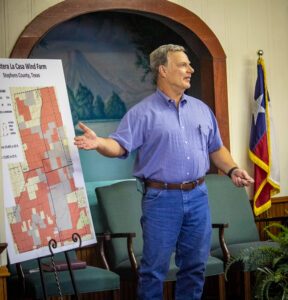
Zola George, who owns property in southeastern Stephens County, spoke at a meeting of landowners in August, as well as at almost every regular school board meeting since May. He is opposed to the wind farm. (Photo by Tony Pilkington/Breckenridge Texan)
Some residents in favor of the proposed wind farm have attended the meetings, but none have signed up to speak to the board.
When Zola George spoke at the May 4 meeting, he explained to the school board that his wife’s family has lived in Stephens County since at least 1906. George’s father-in-law is the late R.L. “PeeWee” Miller. Over the years, George and his wife, Nancy, have taken their children and now their grandchildren to the family home, and now they have purchased additional property in the area, where they have planned to retire.
“I’m just concerned about the noise, the traffic, the impact on the wildlife,” he said. “It’s really very much a concern.”
When Steve Dempsey spoke at the June 13 meeting, he expressed concerns about how the wind turbines’ foundations will affect the water wells in the area. At other meetings, he has said that he has had trouble getting information from NextEra’s representatives about the proposed wind farm.
While there may be some protections for the surface right’s owners, the courts in Texas have sided with the property owner’s right to put up a windmill, according to Tiffany Dowell Lashmet, an attorney and agricultural law specialist with the Texas A&M ArgriLife Research and Extension Center in Amarillo. There is nothing to stop somebody from putting up a wind farm on their property, even if their neighbors object to it because it will affect the aesthetics of their property.
“There’s at least one case here in Texas where a neighboring landowner tried to argue that the wind turbines were like a visual nuisance or like an aesthetic nuisance. And the court said that we don’t recognize that claim here in Texas,” she said.
Lashmet said doesn’t know of any cases that are currently pending in Texas at the Appellate level, and that although it’s difficult to keep up with all the cases at the trial court level, she doesn’t know whether there are any cases pending.

Stephens County landowner Steve Dempsey speaks out against the proposed wind farm at a recent BISD Board of Trustees meeting. (Photo by Tony Pilkington/Breckenridge Texan)
WIND RIGHTS
Another legal topic regarding the wind farm industry is whether wind rights for property can be severed from the property like mineral rights can be. According to Lashmet, there is no Texas law prohibiting someone from doing it, but it’s also never been tested in court.
“So there’s never been a Texas Supreme Court case that has ruled whether or not that is a valid reservation of rights,” she said. “So, I say that you can do it. What I probably should say is people are doing it. We’ve never had a case that says you can or can’t, and we don’t have a statute that prohibits it.”
However, she said somebody reserving the wind rights from a piece of property can be a bit more concerning for someone buying the property.
“As you can imagine, I think that the wind right reservation probably is a little bit more concerning for most people looking to purchase property,” she said. “I mean, essentially, what that means is, somebody else would have the power to decide to lease that property for a wind farm, and you as the landowner … the surface owner, wouldn’t really have a say in that property being leased, and you likely wouldn’t get any of the money from that lease.”
Any terms on who receives any payments are going to be subject to negotiation, and the purchaser could negotiate to get some sort of payment, Lashmet said.
“But I mean, the way the reservation works, you would not own the wind rights to the property if somebody else has those and then has the ability to lease them out to a company to build a wind farm,” she said.
Lashmet said the lease for the wind rights would stay on the property even if it’s sold by the surface rights owner, just like mineral rights.
“The lease would stay on the property, so long as it’s properly recorded in the deed records, and the buyer has notice,” she said. “The question, though, I think it would be, who then gets the payment from that lease? And that’s where I think it depends on if you’ve reserved the wind rights or not. So if I buy a property that has a wind lease already on it, and they don’t reserve any wind rights, will the lease then go with that property?”
Because wind farms and wind rights are relatively new concept in Texas, the rights between surface rights owners and the wind rights owners haven’t been tested, Lashmet said.
“The reason that there are some protections for surface owners in oil and gas is that it has been there, it’s been litigated so much. And we know what the law is. We really don’t know on wind rights,” she said. “I’m thinking about all the wind projects I’ve seen… So, … even if they put up multiple turbines on one property, you still graze cattle around them, those guys could farm right up to them. So, I don’t foresee a situation … making it where the surface owner couldn’t do anything on the property.”
STATE PARK
Concerns about the quality of life and visual nuisance issues aren’t limited to Stephens County residents. At the Oct. 17 BISD board meeting, James Adams, the park superintendent for the new Palo Pinto Mountains State Park, spoke to the trustees about his concerns. He also spoke at the BISD public hearing on Nov. 9.
When it is opened, the park will be the first new state park in North Texas in 25 years, and a portion of it will be located in the southeastern part of Stephens County, with the rest in Palo Pinto County. The Texas Parks and Wildlife Foundation describes the area as “a wonderful setting for hiking, mountain biking, camping, horseback riding, fishing, and stargazing” that is expected to attract at least 75,000 visitors annually.
The map included with NextEra’s 313 application shows the southern edges of the proposed wind farm to be anywhere from a little over a mile to 2.5 miles from the northern and western boundaries of the new state park. Other maps show that windmills also could be located in parts of the county that are in the Ranger school district; those wind turbine locations are less than a mile from the new park.
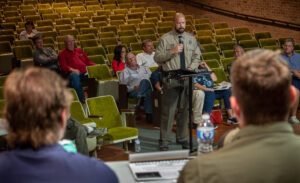
James Adams, the superintendent of the new Palo Pinto Mountains State Park, spoke out against the wind farm at last week’s public hearing, as well as at a recent school board meeting. He said the lights from the wind turbines will affect the night skies and will limit the stargazing the Texas Parks and Wildlife Department expects will attract visitors to the park. (Photo by Tony Pilkington/Breckenridge Texan)
Adams said the park will offer not only outdoor recreation for visitors but also will provide economic stimulus to the region, specifically to Strawn and Breckenridge, in the form of tourism dollars.
“The park’s hills, escarpments, steep slopes…regular surface features…they offer a ton of breathtaking vistas. And visitors can literally see for miles from these places,” Adams said. “After sunset, visitors can enjoy stargazing in one of the few places that the stars are haven’t been choked out by light pollution. This is why if or when the board does consider tax abatements for a wind farm, just north and northwest of your newest state park, we respectfully ask that you consider the impacts. Consider the impacts that parks have on local economies. Consider the impacts that these Goliath structures and flashing lights will have on those viewsheds and night skies. Please consider the impacts that those viewsheds and night skies have on our visitation.”
Although the proposed wind farm is projected to add one job to Stephens County, Adams said the new state park will likely add about 13 state jobs to the area. “One of my staff, in fact, already lives in Breckenridge,” he said. “Consider the impact of those sustainable jobs and jobs that could be created in retail and service industry. In closing, I look forward to working with local communities as we open Palo Pinto Mountain State Park in the centennial year of our state park system. TPWD is deeply proud to be a part of this community, both with what we’re doing with the state park, as well as what our game wardens, wildlife and fisheries biologists do every day. … We’re creating something special here in Stephens and Palo Pinto counties.”
AIR AMBULANCES/FIREFIGHTING
Air ambulances
One of the issues that Earl Brunner brought up when a group of concerned citizens met this summer at New Hope Baptist Church to discuss the proposed wind farm is whether air ambulances and aerial wildfire fighting equipment will be able to operate effectively in an area with wind turbines.

BISD school board member Roy Russell looks over maps and other information as Evan Brunner discusses some of the problems he thinks the wind farm will present for the community. (Photo by Tony Pilkington/Breckenridge Texan)
Brunner is a retired Army helicopter pilot, and his son Evan is a pilot. They are worried that air turbulence created by the wind turbine blades will cause air ambulance helicopters and firefighting air craft to avoid the area, and thereby delay lifesaving measures. Earl Brunner said that he talked to an air ambulance pilot who said he would not fly into an area with windmills.
However, a spokesperson with AirEvac, an air ambulance service that provides medical helicopter transportation in this area, said they say that do not anticipate any problems flying the air ambulances in the area.
“We greatly appreciate the questions about safety as safety of patients, crews and communities is our key focus. We don’t anticipate this to be an issue,” the company said in an emailed statement. “Our air ambulance crews operate to the industry standard safety protocols, and we work to provide emergency medical response where needed, as needed, in our service areas.”
Additionally, James Smith, the fire marshal in Nolan County, which has almost 400 wind turbines, said that he has been with the department for 14 years and doesn’t know of any problems related to helicopters or firefighting and the windmills. Specifically, he recalled a 2011 wildfire that burned 70,000 acres and was fought from the air with no problems.
“We had air drops coming in every day and helicopters coming in with a helicopter pilots flying between the blades,” he said. “We routinely do trainings with Air Evac where we bring them out to sites and have them land. I mean, these windmills are not right on top of each other. They’re spaced out…it’s not like they put them right next to each other; they’ve got pretty good space between them.”
Smith said that in almost every situation they’ve ever had, there’s been somewhere that the helicopter can land. In some cases, the patient may have to be taken from the scene to the helicopter a short distance away, which he said is typical for just about anywhere out in a rural area.
“We’ll have to take them, you know, just to an open field or just no less than less than a quarter mile away, just to be able to get them out to a place where we can get to because you wouldn’t be able to get an ambulance down to a lot of those places,” he said.
Evan Brunner, who is a transport pilot and a flight instructor, acknowledges that air ambulances will still be able to land in the general area, but he maintains that the wind turbines will affect how quickly some patients receive treatment.
“Wind turbines will definitely negatively impact the operational capacity for fire and EMS to operate within the area that the wind turbines are at,” Evan Brunner said. “Can it still be done? Yes, but things need to be altered, and it’s going to have a negative impact on the response time and the effectiveness for these people to operate fire and EMS.”
The location of wind turbines could result in a helicopter having to land further away from a patient and thereby delaying the treatment for the patient, he said after last week’s BISD public hearing. “It could be up to 20 to 30 minutes before DPS or fire or whoever gets there to relocate somebody to a place where the helicopter can pick them up. So, it’s definitely going to have a negative impact on their capacity. … If you have to relocate a victim on the ground, it’s additional time. And who knows how far they’re going to have to move them because if you’re right next to a turbine, you might have to wait half an hour for somebody to get there and move you.”
Wildfires
Evan Brunner expects that the wind turbines will also have an effect on aerial firefighting. “It still will be done. I’m not saying that EMS can’t come in here with a helicopter or they can’t fight fires, but the higher you drop the fire retardant, foam or the water, the less effective it is, which is why they try to get as low as possible on passes.”
Concerning wildfires, Smith said they haven’t had any issues at all in Nolan County. He said they have the firefighting planes routinely drop water on the fires that they have in the area, despite the fact that there are so many wind turbines.
“We had one this year out on the Trent Mesa… There’s windmills all over the place out there, but they weren’t having any trouble bringing planes in and dropping,” he said. “Never had any issues. If anything it’s made it actually a little easier for us to get through the wildfires because they create roads and things in to those windmills, where normally we’d be driving across an open pasture and who knows what. Building roads in there makes it a little easier for us to get in and out of it… I haven’t seen any issues…any negative side to that.”
Smith said they routinely train with the windmill companies doing rescue simulations and calling out an ambulance and the helicopter and having a helicopter come out to a designated place where they land and they coordinate from there.
“They call us out to respond to their rescues; they will go up to bring the patient down. And then we will show up,” he said. “Basically, what they try to do is find out what are the response times going to be … to see what the response times are to be able to get the helicopter where it needs to be, to be able to get the ambulance where it needs to be. So in we’ve never had a problem with finding a place to put a helicopter down there. I’d say they’re not, you know, 20 feet from each other. They’re a pretty good distance away from each other.”
Also weighing in on the topic of fighting wildfires in an area with wind turbines was Erin O’Connor with the Texas Forest Service Forest Resource Protection.
As far as Texas A&M Forest Service aviation operations handle such situations, the decision to fly at any time is the pilot’s decision, she said in a statement. Wind turbines are a hazard, but they’re a known hazard, just like communication towers, powerlines, etc. Pilots and aerial supervisors will determine how to operate around the obstacles safely.
When needed, the Texas A&M Forest Service uses a combination of resources to help local fire departments fight fires. Although the Forest Service does not own any aviation resources, it uses federal aviation contracts through the U.S. Forest Service and Bureau of Land Management for all firefighting aircraft, as necessary.
Although wind turbines may sometimes be a problem, other factors, such as high wind speeds, may also ground aircraft, making them unavailable to assist with response.
“Texas A&M Forest Service and local fire departments are focused on a wholistic approach to wildfire response,” O’Connor said in the statement. “They utilize the appropriate resource while keeping safety of both the public and first responders at the core of every management decision.”
Windmill Fires
Another concern that some local residents have expressed is fires caused by the wind turbines. Smith said he remembers only two such fires in Nolan County in the last 14 years.
“Pretty much, you just stand and watch them burn,” he said. “There’s nothing you can do about it. Protect areas around. Protect the exposures. I mean, we’ve had a few grassfires off of one, but other than that, we really don’t see it much.”
However, there have been wind turbine fires in other areas, for example, during the past few years. At least two burned-out wind turbines can be seen along State Highway 351 between Albany and Abilene.
PROPERTY RIGHTS/FINANCIAL BENEFITS FOR LANDOWNERS
After the May 4 school board meeting and a workshop with the County Commissioners by the NextEra representatives, most of the public conversation has involved those who oppose the approval of the 313 agreement and the installation of the wind farm. But, there are at least 51 leases between NextEra/La Casa Wind LLC and local property owners, and those people have their own opinions about the project.
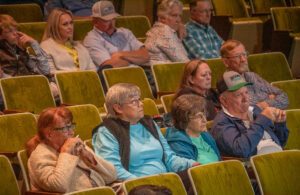
Stephens County residents for and against the proposed wind farm attended the BISD public hearing on Nov. 9. The only members of the public to address the school board were those who are against the project. Click here to see more photos from the hearing. (Photo by Tony Pilkington/Breckenridge Texan)
For the most part, those in favor of the project are supportive of property owners’ rights to do what they want or need to with their own land. Many of the land owners who have leased their property to the wind energy companies use their land to make a living, typically with cattle and/or oil and gas leases.
According to various sources, depending on the type of lease they agree to, the property owners are typically paid for the initial option or lease with the wind energy company. Some companies make annual payments to the landowners, even before a wind turbine is put in place. Then, once windmills are placed on the land, property owners usually receive annual payments, based on the number of windmills on their property.
Cheryl Belson said she agreed to the project about five years ago and considers it a way to keep the land in the family.
“My reasoning is because, well, income – income for everyone, really,” she said. “It’s hard to make a living out here, you know. Landowners own land, and the land might be worth a lot of money, but we can’t just put our hand down and pick it up. We have to generate income from our properties; it’s hard to do that these days.”
Belson said the property has been in her family for over 100 years. She is the fourth generation to own it, and her daughters will be the fifth. She said she has oil leases, grass leases and hunting leases, but she thought she was going to have to sell some of the property before the wind lease happened.
“So, it’s to generate income for all of us, myself and my family, my daughters and their children,” Belson said. “I just thought it would be easier way for me to hold on to my property without having to sell it. And for my children not to think they have to sell it.”
Growing up watching the older generations work the land gives it sentimental value to Belson and she appreciates the work that has gone into keeping it in the family. “I guess that’s the reason why: I’m trying to keep my property and my forefathers’ property,” she said. “And to generate income, so we can still keep it in the family.”
Mike Fields, the Stephens County landowner who was on the committee to investigate the potential for a local wind farm, supports the project. He said his research in other areas revealed people who were able to maintain ownership of their land because of the income provided by a wind farm. He specifically mentioned a woman in the Olney area. “She said, ‘I’ve got an income now.’ She said it was a gift from heaven. But I have a hard time trying to decide why anybody would really want to oppose these,” Fields said.
Mostly, he said, he thinks the decision to have windmills or not should be up to each landowner.
“This is the United States of America,” Fields said. “I think that people that own land ought to be able to make decisions on it, what they want to do with their land, and not have a bunch of protesters trying to get them to change their mind or do something else with their land. You know, that’s not the American way.”
Editor’s Note: The Breckenridge Texan will have more information on this topic in upcoming stories, including a look at how a wind farm might affect property values in the area, as well as some of the predicted benefits and detriments the wind farm might have on the county and school district, and how some area school districts have handled similar situations.
Cutline, top photo: Sara Leon, an attorney with Leon Alcala law firm, talks to the school board and those in attendance at the Nov. 9 public hearing about the proposed wind farm and the Chapter 313 application. Leon represents BISD in the wind farm negotiations with La Casa Wind. (Photo by Tony Pilkington/Breckenridge Texan)
Make sure you don’t miss any of the Breckenridge Texan’s news…click here to sign up for our email newsletter, the Weekly News Roundup. It has links to stories, photo galleries and more! It’s free to sign up, and it comes to you on Monday mornings (sometimes on Tuesdays after a holiday).

































